Beobachtungen:
Oersted
In der Physik ist der Begriff Feld eine wichtige Größe. Man kennt elektrische Felder, Magnetfelder und Gravitationsfelder. felder.htm erdmagnetfeld.htm
In der Regel kann ein Mensch Felder nicht sehen, er kann sie nur mit Hilfsmitteln beobachten und zwar, wenn er einen Probekörper nimmt und die Kraft mißt, die das Feld auf ihn ausübt.
Bevor man eine Meßeinrichtung für ein Feld bauen kann, muß man durch Beobachtung herausfinden, wo, wie oder wann Kräfte auftreten, die durch das Feld hervorgerufen werden.
Es gehört ein große Menge Aufmerksamkeit oder Neugier dazu, um solche Abhängigkeiten zu finden.
Es gibt aber Menschen die "sehen" können, was von den Feldern ausgeht.
strom-sehen.htm bbewegte-materie.htm#kapitel-02-01-06
Solche Beobachter sind eine entscheidende Hilfe, um eine Meßeinrichtung zu bauen oder sie zu verbessern.
Anfang des neunzehnten Jahrhunderts gab es eine Reihe von interessierten Forschern, die den Phänomenen zur Elektrizität und Magnetismus nachgegangen sind. Volta, Galvani, Orsted, Faraday, später Maxwell, Weber usw. ????
Eines der wichtiges Experimente für das Verständnis zur Wechselwirkung von Elektrizität (E) und Magnetismus (M) war die Entdeckung von Christian Oersted in der Zeit 1820, daß elektrischer Strom eine Kraft auf Magnete ausübt.
Viele Jahre später hat Maxwell die Beziehungen zwischen den Größen von E und und von M umfassend in seinen "Maxwellschen Gleichungen" mathematisch formuliert.
/Rettig 2009/ Über Hans Christian Ørsted und die Geisteshaltung hinter der Entdeckung des Elektromagnetismus anno 1820
.??????
 |
| Abb. 01. In einer Glasschale liegt ein Stück Magneteisenstein. Wieviel Zufall oder Neugier war nötig, um herauszufinden, daß diese Schale sich immer in eine spezielle Richtung dreht, wenn sie auf Wasser schwimmt. schluesselexperiment.htm Diesen Effekt nutzt man noch heute beim Kompass aus. aus erdmagnetfeld.htm (FB) |
 |
Abb. 02:aus strom-sehen.htm#kapitel-01-03 |
 |
Abb. 02a:
aus strom-sehen.htm#kapitel-01-03 |
Oersteds Versuch 1820 mit Gleichstrom aus Galvanischen Zellen und einer Kompaßnadel.
die Veröffentlichung: oersted-1820
Fließt durch einen Leiter ein Gleichstrom, dann entsteht ein Magnetfeld. Bei genügender Stärke des Stromes kann das Magnetfeld eine benachbarte Kompaßnadel ablenken.
/Kipnis 2005/ /Snelders 1990/ /Wiederkehr 1991/
http://denstoredanske.dk/It,_teknik_og_naturvidenskab/Fysik/Fysikere_og_naturvidenskabsfolk/Hans_Christian_%C3%98rsted
Original-Literatur von Oersted, Faraday, Riess, Weber, Ampere faraday-literatur.htm
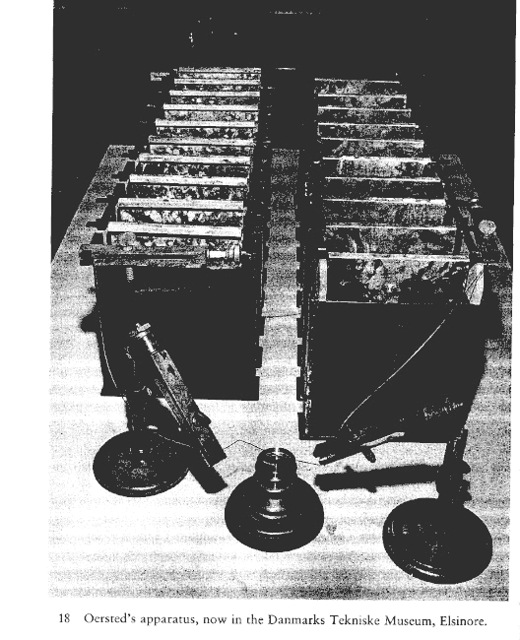 |
| Abb. 03: Kupfer-Zink-Zellen, 20 Stück, jede Zelle war 12 Zoll x 12 Zoll x 2 1/2 Zoll groß (ca. 35 cm x 35 cm x 7,5 cm), Wasser mit 1/16 Schwefelsäure und 1/16 Salpetersäure. Davor steht ein Kompaß, über dem der stromdurchflossene Leiter mit Klemmen gehalten wird. Oersteds Apparat im Technischen Museum in Elsinore. /Snelders 1990/ |
 |
| Abb. 03a: Oerstseds Apparat, Nachbau der Batterie im Langelandsmuseum und im Hintergrund das Bild des Versuchsaufbaus mit Kompaß links vorne steht ein Kompaß, http://www.langelandsmuseum.com/ (FB) |
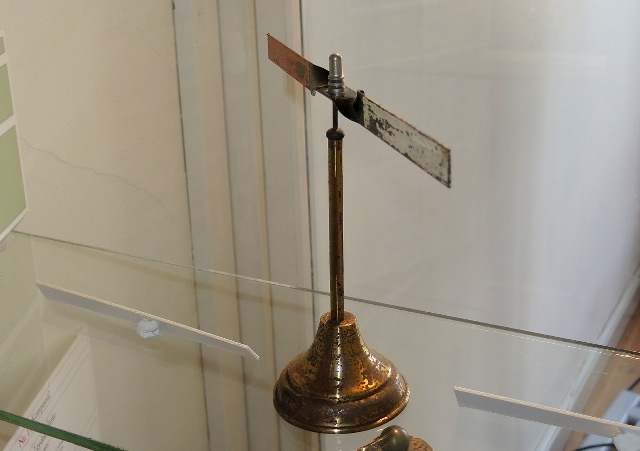 |
| Abb. 03b: Kompaßnadel im Langelandsmuseum http://www.langelandsmuseum.com/ (FB) |
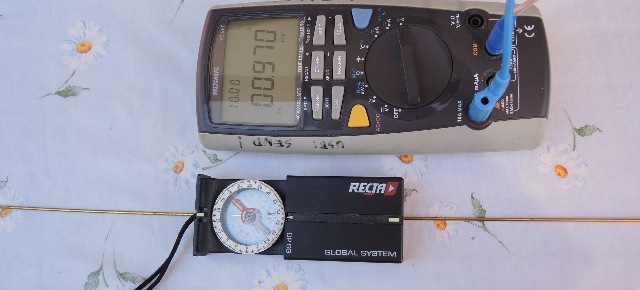 |
| Abb. 03c: Kupferdraht, Gleichstrom 0,97A und Kompaßnadel, die Nadel wird stark abgelenkt. Der Draht liegt in Nord-Südrichtung. (FB) |
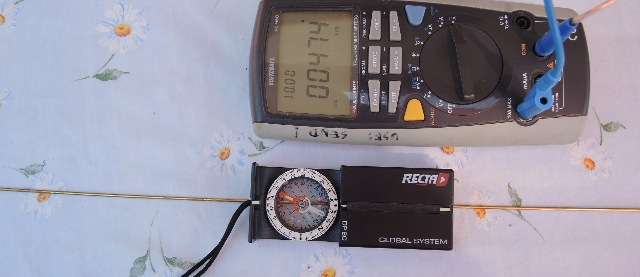 |
| Abb. 03d: Kupferdraht, Gleichstrom 0,47A und Kompaßnadel, die Nadel wird schwach abgelenkt. (FB) |
 |
| Abb. 03e: Kupferdraht, Gleichstrom 0,13A und Kompaßnadel , die Nadel wird kaum noch abgelenkt. (FB) |
Oersteds Versuch in der Darstellung von J.C. Maxwell
 |
| Abb. 04: Oersteds Versuch in der Darstellung von Maxwell. Durch den senkrecht aufgehängten Draht fließt ein Gleichstrom. Um ihn herum ist eine Scheibe, auf der zwei Magnete liegen. Bei dieser Anordnung erfährt die Scheibe ein Drehmoment, wenn der Strom fließt. (aus Simonyi - Kulturgeschichte der Physik (2001) Verlag Harry-Deutsch) |
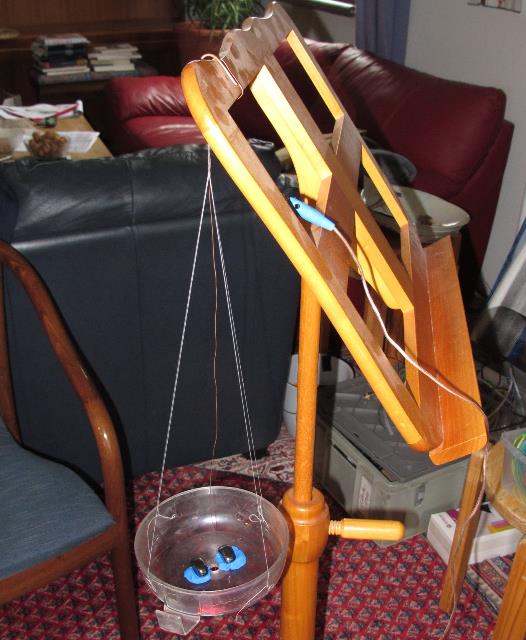 |
| Abb. 05: Nachbau 2013, mit zwei Ni-Fe-Magneten (FB) |
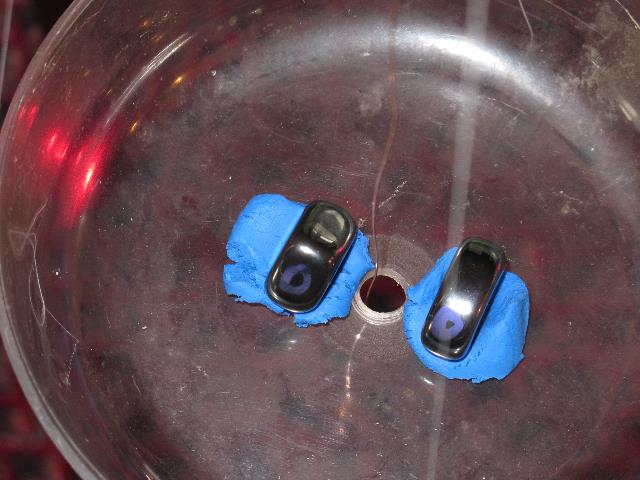 |
| Abb. 06: Beide Magnete liegen auf Knetmasse (FB) |
 |
| Abb. 07: Protokoll der Bewegung mit einem Video. Mit
einem Laserstrahl läßt sich der zeitliche Verlauf der Bewegung so besser
beobachten. (FB) |
2. Geräte
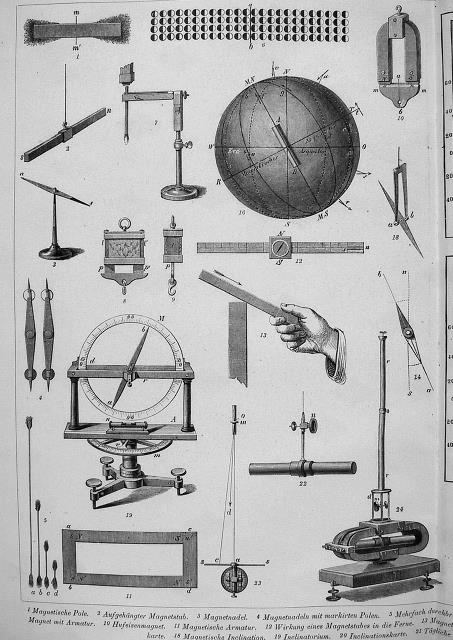 |
| Abb. 08: Magnetismus, Darstellung in einem Atlas Magnetnadeln, Inclinatorium (19), Magnetometer, Atlas der Physik (Johann Müller, 1871) Buch ausleihen ?????? Tabelle vervollständigen 1 Magnetische Pole 2. Aufgehängter Magnetstab 3. Magnetnadel 4. Magnetnadeln mit markierten Polen 5. Mehrfach durchbr 6. 7. 8. 9. Magnet mit Armatur, 10 Hufeisenmagnet 11 Magnetische Armatur 12 Wirkung eines Magnetstabes in die Ferne, 13 Magnet 14 15 16 17 karte 18 Magnetische Inclination 19 Inclinatorium 20 Inclinationskarte 21 Tägliche |
 |
| Abb. 08: Geräte zu Versuchen mit Magnetismus und Elektrizität, thermoelektrische Säule (38), astatisches Galvanometer (20), Oersted's Fundamentalversuch (18), Original aus UB kopieren ?????? Atlas der Physik (Johann Müller, 1871) |
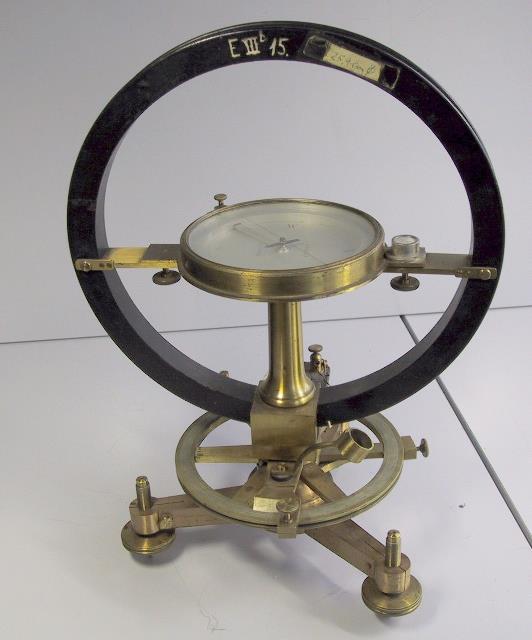 |
Abb. 09: Amperemeteraus: steinkreise-06.htm#kapitel06-04 |
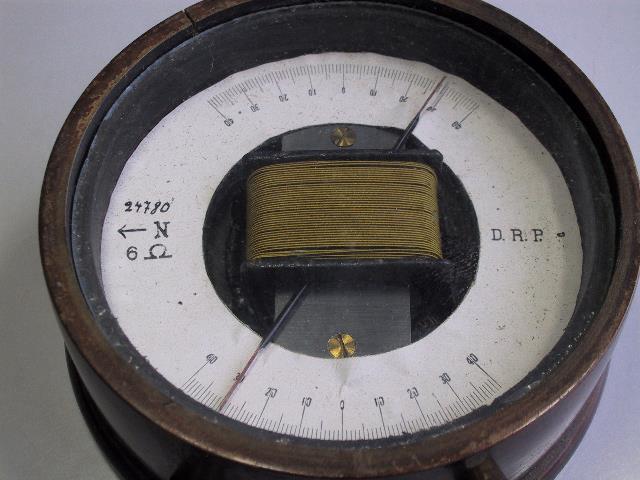 |
Abb. 10: Amperemeteraus steinkreise-06.htm#kapitel06-04 |
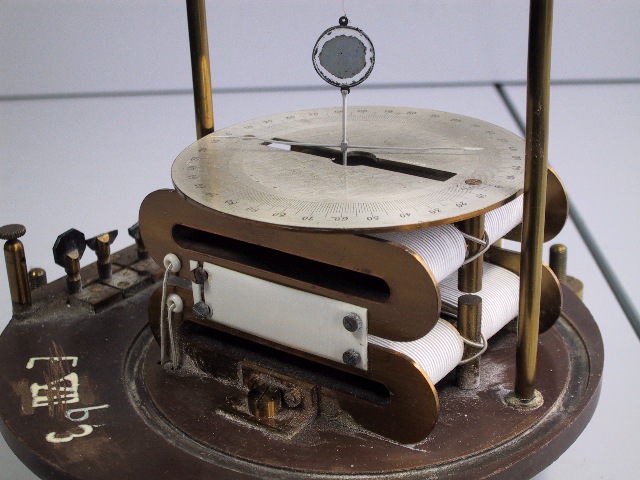 |
| Abb. 11: Astatisches Galvanometer, zwei entgegengesetzt gewickelte Spulen und zwei entgegengesetzt aufgehängte Magnetnadeln heben die Wirkung des Erdmagnetfeldes auf. Messung erfolgt ohne Einfluß des Erdfeldes. Am unteren Ende vom Torsionsfaden hängt ein Spiegel für einen Lichtzeiger. (FB) |
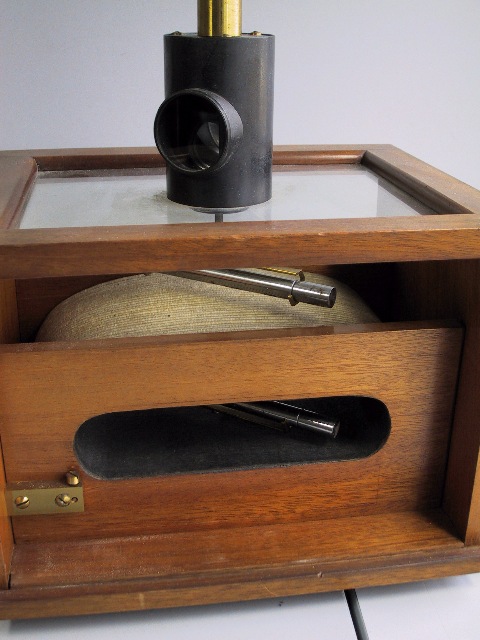 |
| Abb. 12: Eine Spule und zwei entgegengesetzte Magnete, der eine innen und der andere außerhalb der Spule. Das Erdmagnetfeld hat keinen Einfluß. In dem schwarzen Gehäuse ist ein Drehspiegel zur Beobachtung mit Lichtzeiger angebracht. (FB) |
 |
| Abb. 13: Torsions-Galvanometer Siemens&Halske 1883 (FB) |
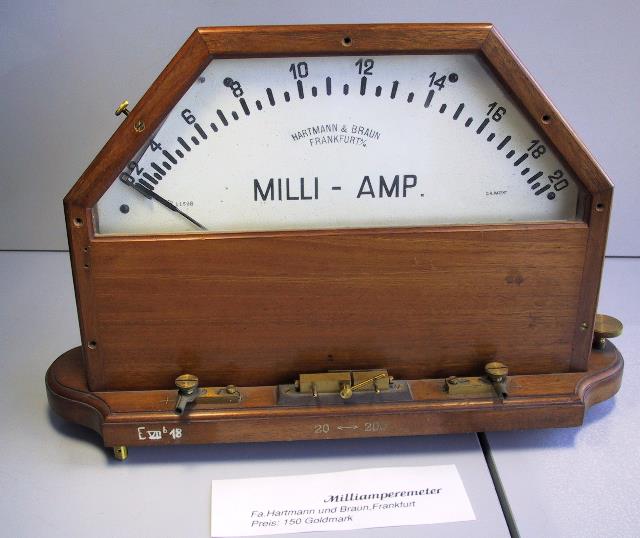 |
| Abb. 14: Milliamperemeter, Fa. Hartmann und Braun Frankfurt, Im Inventar der Bergakademie Clausthal vermerkt: Preis 150 Goldmark (FB) |
H.C. Oersted, Annals of Philosophy 16, 273-277 (1820)
EXPERIMENTS ON THE EFFECT OF A CURRENT OF ELECTRICITY ON THE MAGNETIC NEEDLE
"By John Christian Oersted, Knight of the Order of Danneborg, Professor of Natural Philosophy, and Secretary to the Royal Society of Copenhagen.
The first experiments respecting the subject which I mean at present to explain, were made by me last winter, while lecturing on electricity, galvanism, and magnetism, in the University. It seemed demonstrated by these experiments that the magnetic needle was moved from its position by the galvanic apparatus, but that the galvanic circle must be complete, and not open, which last method was tried in vain some years ago by very celebrated philosophers. But as these experiments were made with a feeble apparatus, and were not, therefore, sufficiently conclusive, considering the importance of the subject, I associated myself with my friend Esmarck to repeat and extend them by means of a very powerful galvanic battery, provided by us in common. Mr. Wleugel, a Knight of the Order of Danneborg, and at the head of the Pilots, was present at, and assisted in, the experiments. There were present likewise Mr. Hauch, a man very well skilled in the Natural Sciences, Mr. Reinhardt, (S. 274)Professor of Natural History, Mr. Jacobsen, Professor of Medicine, and that very skilful chemist, Mr. Zeise, Doctor of Philosophy. I had often made experiments by myself ; but every fact which I had observed was repeated in the presence of these gentlemen. The galvanic apparatus which we employed consists of twenty copper troughs, the length and height of each of which was 12 inches; but the breadth scarcely exceeded 2 1/2 inches. Every trough is supplied with two plates of copper, so bent that they could carry a copper rod, which supports the zinc plate in the water of the next trough. The water of the troughs contained one-sixtieth of its weight of sulphuric acid, and an equal quantity of nitric acid. The portion of each zinc plate sunk in the water is a square whose side is about 10 inches in length. A smaller apparatus will answer provided it be strong enough to heat a metallic wire red hot.
The opposite ends of the galvanic battery were joined by a metallic wire, which, for shortness sake, we shall call the uniting conductor, or the uniting wire. To the effect which takes place in this conductor and in the surrounding space, we shall give the name of the conflict of electricity.
Let the straight part of this wire be placed horizontally above the magnetic needle, properly suspended, and parallel to it. If necessary, the uniting wire is bent so as to assume a proper position for the experiment. Things being in this state, the needle will be moved, and the end of it next the negative side of the battery will go westward. If the distance of the uniting wire does not exceed three-quarters of an inch from the needle, the declination of the needle makes an angle of about 45°. If the distance is increased, the angle diminishes proportionally. The declination likewise varies with the power of the battery.
The uniting wire may change its place, either towards the east or west, provided it continue parallel to the needle, without any other change of the effect than in respect to its quantity. Hence the effect cannot be ascribed to attraction ; for the same pole of the magnetic needle, which approaches the uniting wire, while placed on its east side, ought to recede from it when on the west side, if these declinations depended on attractions and repulsions. The uniting conductor may consist of several wires, or metallic ribbons, connected together. The nature of the metal does not alter the effect, but merely the quantity. Wires of platinum, gold, silver, brass, iron, ribbons of lead and tin, a mass of mercury, were employed with equal success. The conductor does not lose its effect, though interrupted by water, unless the interruption amounts to several inches in length. The effect of the uniting wire passes to the needle through glass, metals, wood, water, resin, stoneware, stones; for it is not taken away by interposing plates of glass, metal or wood. (S. 275)
Even glass, metal, and wood, interposed at once, do not destroy, and indeed scarcely diminish the effect. The disc of the electrophorus, plates of porphyry, a stoneware vessel, even filled with water, were interposed with the same result. We found the effects unchanged when the needle was included in a brass box filled with water. It is needless to observe that the transmission of effects through all these matters has never before been observed in electricity and galvanism. The effects, therefore, which take place in the conflict of electricity are very different from the effects of either of the electricities. If the uniting wire be placed in a horizontal plane under the magnetic needle, all the effects are the same as when it is above the needle, only they are in an opposite direction ; for the pole of the magnetic needle next the negative end of the battery declines to the east.
That these facts may be the more easily retained, we may use this formula –– the pole above which the negative electricity enters is turned to the west; under which, to the east.
If the uniting wire is so turned in a horizontal plane as to form a gradually increasing angle with the magnetic meridian, the declination of the needle increases, if the motion of the wire is towards the place of the disturbed needle ; but it diminishes if the wire moves further from that place. When the uniting wire is situated in the same horizontal plane in which the needle moves by means of the counterpoise, and parallel to it, no declination is produced either to the east or west ; but an inclination takes place, so that the pole, next which the negative electricity enters the wire, is depressed when the wire is situated on the west side, and elevated when situated on the east side.
If the uniting wire be placed perpendicularly to the plane of the magnetic meridian, whether above or below it, the needle remains at rest, unless it be very near the pole ; in that case the pole is elevated when the entrance is from the west side of the wire, and depressed, when from the east side.
When the uniting wire is placed perpendicularly opposite to the pole of the magnetic needle, and the upper extremity of the wire receives the negative electricity, the pole is moved towards the east ; but when the wire is opposite to a point between the pole and the middle of the needle, the pole is moved towards the west. When the upper end of the wire receives positive electricity, the phenomena are reversed.
If the uniting wire is bent so as to form two legs parallel to each other, it repels or attracts the magnetic poles according to the different conditions of the case. Suppose the wire placed opposite to either pole of the needle, so that the plane of the parallel legs is perpendicular to the magnetic meridian, and let the eastern leg be united with the negative end, the western leg with the positive end of the battery: in that case the nearest (276) pole will be repelled either to the east or west according to the position of the plane of the legs. The eastmost leg being united with the positive, and the westmost with the negative side of the battery, the nearest pole will be attracted. When the plane of the legs is placed perpendicular to the place between the pole and the middle of the needle, the same effects recur but reversed.
A brass needle, suspended like a magnetic needle, is not moved by the effect of the uniting wire. Likewise needles of glass and of gum lac remain unacted on.
We may now make a few observations towards explaining these phenomena. The electric conflict acts only on the magnetic particles of matter. All non-magnetic bodies appear penetrable by the electric conflict, while magnetic bodies, or rather their magnetic particles, resist the passage of this conflict. Hence they can be moved by the impetus of the contending powers.
It is sufficiently evident from the preceding facts that the electric conflict is not confined to the conductor, but dispersed pretty widely in the circumjacent space.
From the preceding facts we may likewise infer that this conflict performs circles ; for without this condition it seems impossible that the one part of the uniting wire, when placed below the magnetic pole, should drive it towards the east, and when placed above it towards the west ; for it is the nature of a circle that the motions in opposite parts should have an opposite direction. Besides, a motion in circles, joined with a progressive motion, according to the length of the conductor, ought to form a conchoidal or spiral line ; but this, (277) unless I am mistaken, contributes nothing to explain the phenomena hitherto observed.
All the effects on the north pole above-mentioned are easily understood by supposing that negative electricity moves in a spiral line bent towards the right, and propels the north pole, but does not act on the south pole. The effects on the south pole are explained in a similar manner, if we ascribe to positive electricity a contrary motion and power of acting on the south pole, but not upon the north. The agreement of this law with nature will be better seen by a repetition of the experiments than by a long explanation. The mode of judging of the experiments will be much facilitated if the course of the electricities in the uniting wire be pointed out by marks or figures.
I shall merely add to the above that I have demonstrated in a book published five years ago that heat and light consist of the conflict of the electricities. From the observations now stated, we may conclude that a circular motion likewise occurs in these effects. This I think will contribute very much to illustrate the phenomena to which the appellation of polarization of light has been given. Copenhagen, July 21, 1820
JOHN CHRISTIAN OERSTED"
weitere Arbeiten von Oersted faraday-literatur.htm#oersted
Literatur: b-literatur.htm
 |
www.biosensor-physik.de | (c) 16.02.2014 - 18.01.2021 F.Balck |
© BioSensor-Physik 2021
· Impressum
